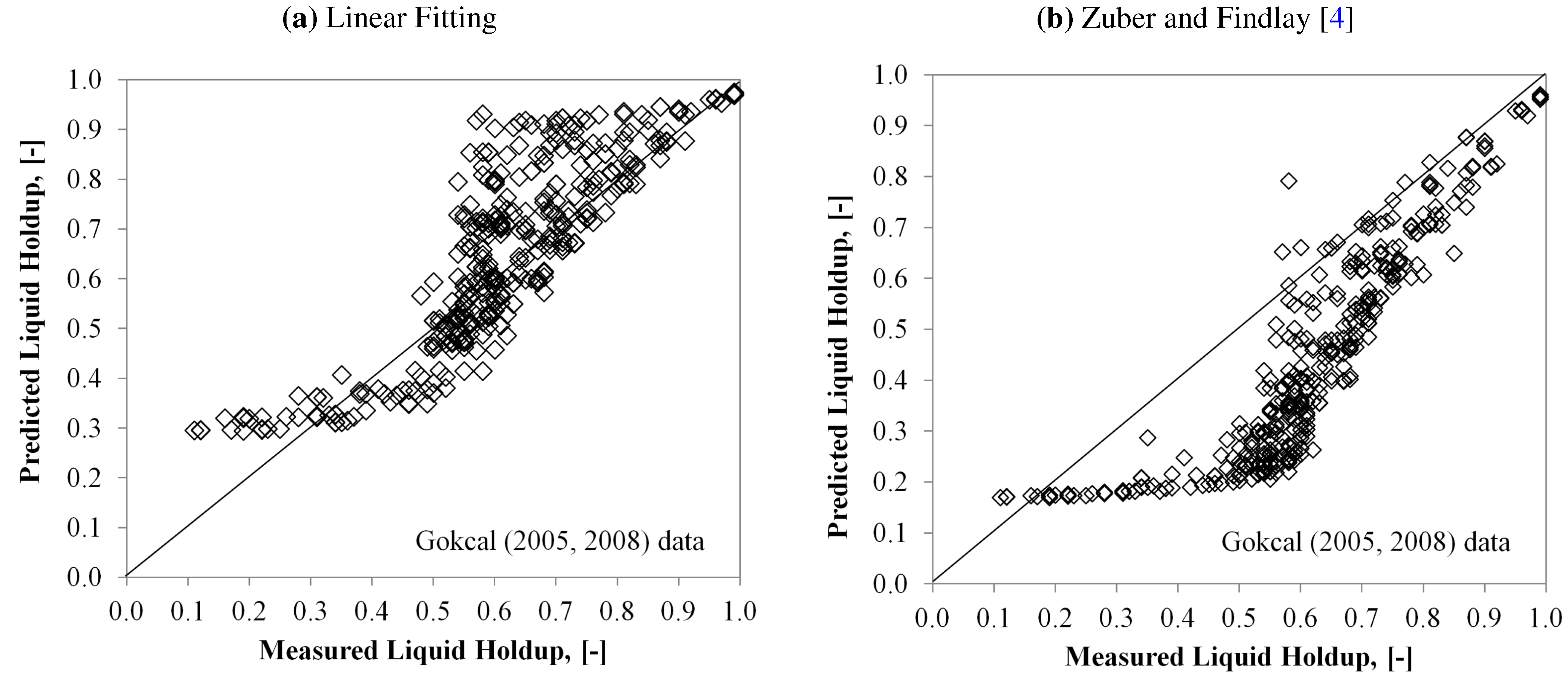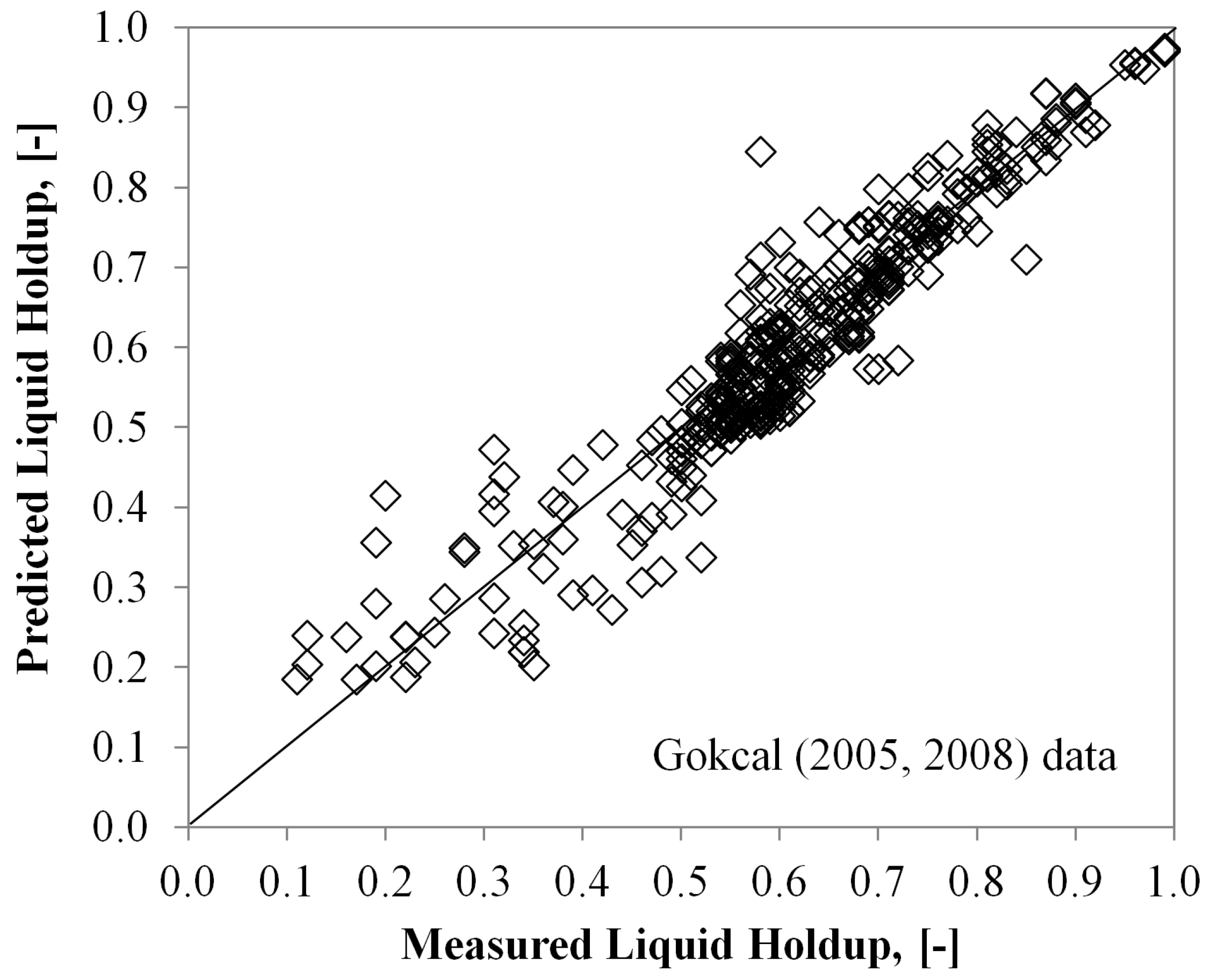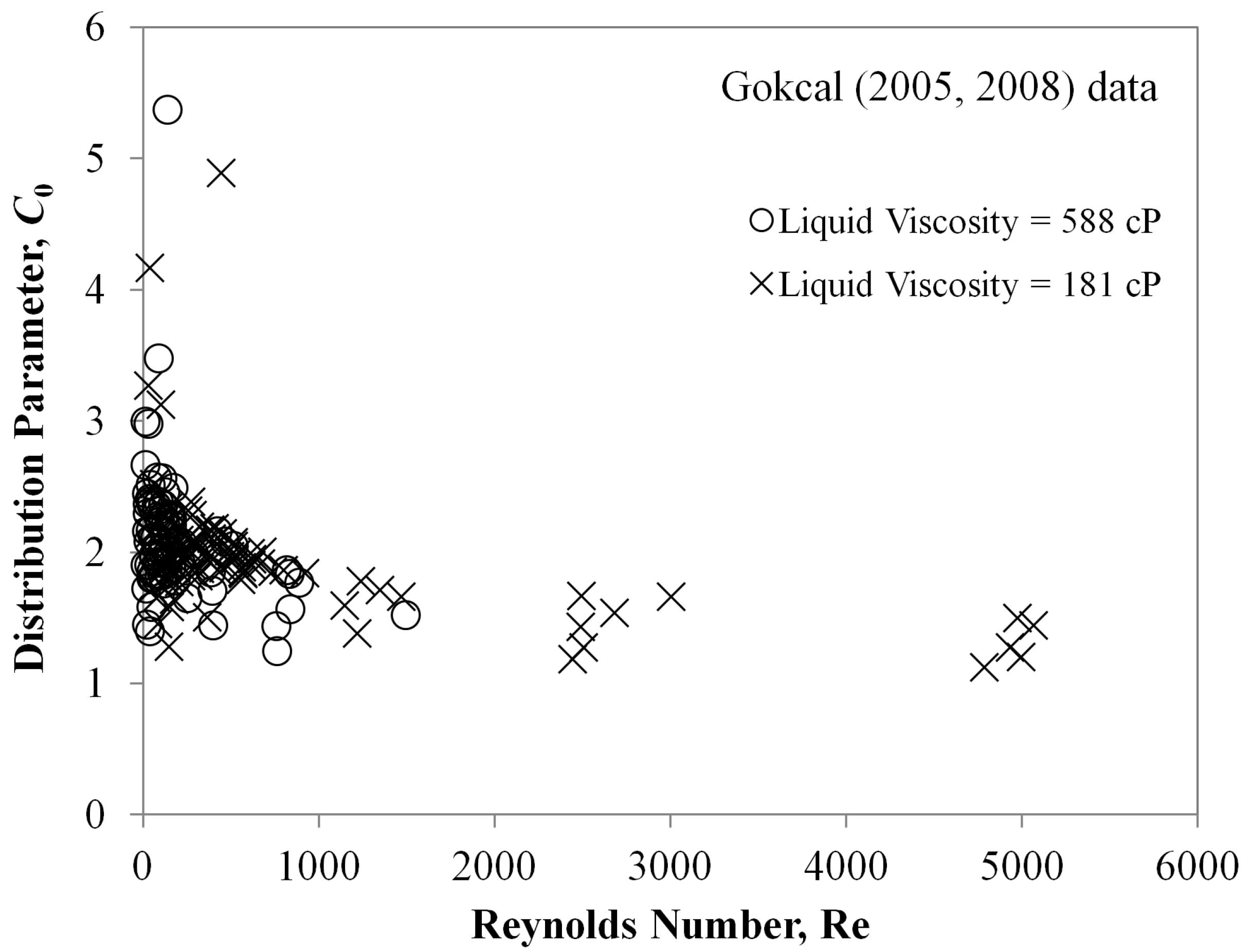An Efficient Drift-Flux Closure Relationship to Estimate Liquid Holdups of Gas-Liquid Two-Phase Flow in Pipes
Abstract
:1. Introduction
2. Methodology
2.1. Procedure to Predict Liquid Holdups Using Drift-Flux Closure Relationship Correlation
2.1.1. Datasets and Comparative Models
| Variable | Inclination angle (Degree) | Gas superficial velocity (m/s) | Liquid superficial velocity (m/s) | Gas density (kg/m3) | Liquid density (kg/m3) | Gas viscosity (N-s/m2) | Liquid viscosity (N-s/m2) | Liquid/Gas surface tension (N/m) |
|---|---|---|---|---|---|---|---|---|
| Max. value | 10 | 15.0 | 1.000 | 3.000 | 820.00 | 0.000018 | 0.002 | 0.032 |
| Min. value | -10 | 0.1 | 0.001 | 2.000 | 800.00 | 0.000018 | 0.001 | 0.032 |
| Property | Experimental data | |||||
|---|---|---|---|---|---|---|
| Vigneron et al. [13] | Fan [14] | Magrini [15] | Gokcal [16,17] | Felizola [18] | Roumazeilles [19] | |
| Fluid type | Gas-liquid | Gas-liquid | Gas-liquid | Gas-liquid | Gas-liquid | Gas-liquid |
| # of data | 30 | 351 | 140 | 356 | 89 | 113 |
| Length (m) | 420 | 112.8 | 17.5 | 18.9 | 15 | 19 |
| Pipe diameter (m) | 0.0779 | 0.0508(Small) 0.1496(Large) | 0.0762 | 0.0508 | 0.051 | 0.051 |
| Inclination angle (°) | 0 | −2,−1,0, | 0,10,20,45, | 0 | 0,10,20,30,40, | 0,−3,−5, |
| (−:downward, +:upward) | +1,+2 | 60,75,90 | 50,60,70,80,90 | −10,−20,−30 | ||
| Gas flow rate (Sm3/h) | 14.16∼451.65 | 35.96∼187.53 (Small) 311.90∼1626.32 (Large) | 600.87∼1351.15 | 0.66∼148.12 | 2.87∼24.71 | 6.72∼68.81 |
| Liquid flow rate (m3/h) | 0.33∼14.13 | 0.0019∼0.38 (Small) 0.016∼3.30 (Large) | 0.056∼0.66 | 0.073∼12.84 | 0.37∼10.96 | 6.50∼17.93 |
| Gas density (kg/m3) | 1.942∼4.230 | 1.166∼2.902 | 1.31∼1.71 | 1.12∼4.50 | 2.09∼3.48 | 1.938∼3.306 |
| Liquid density (kg/m3) | 809.7 | 947∼1000 | 995∼997 | 768.7∼885 | 796.8∼810 | 800.923∼823.349 |
| Gas viscosity (Pa·s) | 0.0000187 | 0.000018 | 0.000018 | 0.000018 | 0.0000187 | 0.000019 |
| Liquid viscosity (Pa·s) | 0.05527 | 0.001 | 0.001 | 0.178∼0.601 | 0.00128∼0.00167 | 0.0014∼0.00219 |
| Authors | Model expressions |
|---|---|
| Zuber and Findlay [4] | |
| Ishii [10] | For churn turbulent flow: |
| Liao et al. [20] | For churn turbulent flow: |
| Jowitt et al. [21] | |
| Sonnenburg [22] | |
| Bestion [23] | |
| Kataoka and Ishii [24] | |
| , | |
| Low viscosity case: | |
| for | |
| for | |
| Higher viscosity case: | |
| for | |
| Shi et al. [11] | |
| , | |
| for | |
| critical Kutateladze number for | |
| Fabre and Line [8] |
3. Results and Discussion
3.1. New Closure Relationship
3.2. Prediction Accuracy of the Developed Model



| Model | Closure relationship | Mean absolute error (Standard deviation) | All data | ||||||
|---|---|---|---|---|---|---|---|---|---|
| Vigneron et al. [13] | Fan(Small) [14] | Fan(Large) [14] | Magrini [15] | Felizola [18] | Roumazeilles [19] | Gokcal [16,17] | |||
| The proposed model | Equations (3) & (4) | 0.10684 | 0.14673 | 0.12803 | 0.15619 | 0.06612 | 0.08246 | 0.04234 | 0.09584 |
| (0.06402) | (0.01221) | (0.02506) | (0.00369) | (0.05319) | (0.04446) | (0.03755) | (0.05684) | ||
| The comparative models | Linear fitting | 0.12319 | 0.06109 | 0.03886 | 0.00330 | 0.18692 | 0.06161 | 0.12400 | 0.08272 |
| (0.07298) | (0.04256) | (0.02519) | (0.00315) | (0.08584) | (0.02402) | (0.08556) | (0.07984) | ||
| Zuber and Findlay[4] () | 0.09071 | 0.16578 | 0.14449 | 0.16257 | 0.05842 | 0.09978 | 0.17548 | 0.14708 | |
| (0.06240) | (0.01303) | (0.02425) | (0.00353) | (0.04735) | (0.04860) | (0.09578) | (0.07076) | ||
| Ishii [10] | 0.08492 | 0.16846 | 0.14830 | 0.15934 | 0.08251 | 0.10632 | 0.13716 | 0.13759 | |
| (0.05610) | (0.01564) | (0.02397) | (0.00334) | (0.05699) | (0.04519) | (0.08224) | (0.05987) | ||
| Liao et al. [20] | 0.11962 | 0.09651 | 0.00288 | 0.15477 | 0.29511 | 0.18035 | 0.20556 | 0.14988 | |
| (0.10789) | (0.07193) | (0.00522) | (0.00385) | (0.08743) | (0.05203) | (0.09229) | (0.10885) | ||
| Jowitt et al. [21] | 0.08620 | 0.20468 | 0.13984 | 0.14487 | 0.14258 | 0.15421 | 0.09646 | 0.13645 | |
| (0.06638) | (0.01893) | (0.02522) | (0.00624) | (0.06498) | (0.05117) | (0.06434) | (0.06028) | ||
| Sonnenburg [22] | 0.15635 | 0.26991 | 0.27515 | 0.24188 | 0.20085 | 0.19128 | 0.08344 | 0.18856 | |
| (0.23257) | (0.02589) | (0.02690) | (0.00332) | (0.23483) | (0.10169) | (0.06600) | (0.12271) | ||
| Bestion [23] | 0.15688 | 0.16070 | 0.27793 | 0.06203 | 0.30781 | 0.14751 | 0.15181 | 0.17560 | |
| (0.14045) | (0.07811) | (0.06747) | (0.01472) | (0.08495) | (0.01611) | (0.09781) | (0.10610) | ||
| Kataoka and Ishii [24] | 0.08992 | 0.16002 | 0.14859 | 0.15897 | 0.06834 | 0.10145 | 0.15957 | 0.14214 | |
| (0.06066) | (0.01327) | (0.02397) | (0.00338) | (0.05245) | (0.04586) | (0.09203) | (0.06595) | ||
| Shi et al. [11] | 0.19551 | 0.01404 | 0.02644 | 0.00701 | 0.07616 | 0.02951 | 0.24502 | 0.10324 | |
| (0.08131) | (0.01138) | (0.02163) | (0.00381) | (0.05076) | (0.02098) | (0.13133) | (0.13101) | ||
3.3. Validation of the New Proposed Model

| Model | Closure relationship | Mean abs. err. | Std. dev. |
|---|---|---|---|
| The proposed model | Equations (3) & (4) | 0.04340 | 0.04960 |
| The comparative models | Linear fitting | 0.13955 | 0.12270 |
| Linear fitting (Schmidt et al., 2008) | 0.09124 | 0.06950 | |
| Zuber and Findlay[4] () | 0.15163 | 0.10307 | |
| Ishii[10] | 0.12767 | 0.09334 | |
| Liao et al.[20] | 0.14036 | 0.09303 | |
| Jowitt et al.[21] | 0.11045 | 0.08086 | |
| Sonnenburg[22] | 0.09612 | 0.07091 | |
| Bestion[23] | 0.13291 | 0.09604 | |
| Kataoka and Ishii[24] | 0.14364 | 0.09971 | |
| Shi et al.[11] | 0.21452 | 0.15823 |
4. Conclusions
Acknowledgments
Nomenclature:
Distribution parameter, (-) * | |
Drift velocity, (m/s) | |
Gas velocity, (m/s) | |
Mixture velocity, (m/s) | |
Superficial gas velocity, (m/s) | |
Superficial liquid velocity, (m/s) | |
Liquid holdup, (-) | |
| Re | Reynolds number, (-) |
Gas density, (kg/m3) | |
Liquid density, (kg/m3) | |
| μ | Viscosity, (Pa·s) |
Gas void fraction, (-) | |
| σ | Surface tension, (N/m) |
| θ | Pipe inclination angle, (°) |
| A, B | Coefficient constants, (-) |
Hydraulic diameter, (-) | |
Viscosity number, (-) |
Subscription
| G | Gas phase |
| L | Liquid phase |
| * dimensionless |
References
- Prado, M.G. A Block Implicit Numerical Solution Technique for Two-Phase Multidimensional Steady State Flow. Ph.D. Dissertation, The University of Tulsa, Tulsa, OK, USA, 1995. [Google Scholar]
- Ishii, M.; Hibiki, T. Thermo-Fluid Dynamics of Two-Phase Flow; Springer: New York, NY, USA, 2005. [Google Scholar]
- Nicklin, D.J. Two-phase bubble flow. Chem. Eng. Sci. 1962, 17, 693–702. [Google Scholar] [CrossRef]
- Zuber, N.; Findlay, J.A. Average volumetric concentration in two-phase flow Systems. J. Heat Transf. 1965, 87, 453–468. [Google Scholar] [CrossRef]
- Coddington, P.; Macian, R. A study of the performance of void fraction correlations used in the context of drift-flux two-phase flow models. Nucl. Eng. Des. 2002, 215, 199–216. [Google Scholar] [CrossRef]
- França, F.; Lahey, R.T. The use of drift-flux techniques for the analysis of horizontal two-phase flows. Int. J. Multiph. Flow 1992, 18, 787–801. [Google Scholar] [CrossRef]
- Danielson, T.J.; Fan, Y. Relationship between mixture and two-fluid models. In Preceedings of 14th International Conference on Multiphase Production Technology, Cannes, France, 17–19 June 2009; Volume 14, pp. 479–490.
- Fabre, J.; Line, A. Modeling of two-phase slug flow. Annu. Rev. Fluid Mech. 1992, 24, 21–46. [Google Scholar] [CrossRef]
- Goda, H.; Hibiki, T.; Kim, S.; Ishii, M.; Uhle, J. Drift-flux model for downward two-phase flow. Int. J. Heat Mass Transf. 2003, 46, 4835–4844. [Google Scholar] [CrossRef]
- Ishii, M. One Dimensional Drift-Flux Model and Constitutive Equations for Relative Motion between Phases in Various Two-Phase Flow Regimes; Technical Report for Argonne National Laboratory: Lemont, IL, USA, 1977. [Google Scholar]
- Shi, H.; Holmes, J.; Diaz, L.; Durlofsky, L.J.; Aziz, K. Drift-flux parameters for three-phase steady-state flow in wellbores. In Proceedings of SPE Annual Technical Conference and Exhibition, Houston, TX, USA, 26–29 September 2004; Society of Petroleum Engineers: Allen, TX, USA, 2005; pp. 130–137. [Google Scholar]
- Shen, X.; Matsui, R.; Mishima, K.; Nakamura, H. Distribution parameter and drift velocity for two-phase flow in a large diameter pipe. Nucl. Eng. Des. 2010, 240, 3991–4000. [Google Scholar] [CrossRef]
- Vigneron, F.; Sarica, C.; Brill, J.P. Experimental analysis of imposed two-phase flow transients in horizontal pipelines. In Preceedings of the BHR Group 7th International Conference, Cannes, France, 7–9 June 1995; pp. 199–217.
- Fan, Y. An Investigation of Low Liquid Loading Gas-Liquid Stratified Flow in Near-Horizontal Pipes. Ph.D. Disseration, University of Tulsa, Tulsa, OK, USA, 2005. [Google Scholar]
- Magrini, K.L. Liquid Entrainment in Aannular Gas-Liquid Flow in Inclined Pipes. Master’s Thesis, University of Tulsa, Tulsa, OK, USA, 2009. [Google Scholar]
- Gokcal, B. Effects of High Viscosity on Two-Phase Oil-Gas Flow Behaviour in Horizontal Pipes. Master’s Thesis, University of Tulsa, Tulsa, OK, USA, 2005. [Google Scholar]
- Gokcal, B. An Experimental and Theoretical Investigation of Slug Flow for High Oil Viscosity in Horizontal Pipes. Ph.D. Dissertation, University of Tulsa, Tulsa, OK, USA, 2008. [Google Scholar]
- Felizola, H. Slug Flow in Extended Reach Directional Wells. Master’s Thesis, University of Tulsa, Tulsa, OK, USA, 1992. [Google Scholar]
- Roumazeilles, P. An Experimental Study of Downward Slug Flow in Inclined Pipes. Master’s Thesis, University of Tulsa, Tulsa, OK, USA, 1994. [Google Scholar]
- Liao, L.; Parlos, A.; Griffith, P. Heat Transfer, Carryover and Fall Back in PWR Steam Generators during Transients; Technical Report NUREG/CR-4376 EPRI-NP-4298; Department of Nuclear Engineering, Massachusetts Institute of Technology: Cambridge, MA, USA, 1985. [Google Scholar]
- Pearson, K.; Cooper, C.; Jowitt, D. The THETIS 80% Blocked Cluster Experiment, Part 5: Level Swell Experiments; Technical Report for AEEW-R; AEEE Winfrith Safety and Engineering Science Division: London, UK, 1984. [Google Scholar]
- Sonnenburg, H.G. Full-range drift-flux model base on the combination of drift-flux theory with envelope theory. In Preceedings of 4th International Topical Meeting on Nuclear Reactor Thermal-Hydraulics (NURETH-4), Karlsruhe, Germany, 10–13 October 1989; Volume 2, pp. 1003–1009.
- Bestion, D. The physical closure laws in the CATHARE code. Nucl. Eng. Des. 1990, 124, 229–245. [Google Scholar] [CrossRef]
- Kataoka, I.; Ishii, M. Drift flux model for large diameter pipe and new correlation for pool void fraction. Int. J. Heat Mass Transf. 1987, 30, 1927–1939. [Google Scholar]
- Schmidt, J.; Giesbrecht, H.; van der Geld, C.W.M. Phase and velocity distributions in vertically upward high-viscosity two-phase flow. Int. J. Multiph. Flow 2008, 34, 363–374. [Google Scholar] [CrossRef]
© 2012 by the authors. Licensee MDPI, Basel, Switzerland. This article is an open access article distributed under the terms and conditions of the Creative Commons Attribution license ( http://creativecommons.org/licenses/by/3.0/).
Share and Cite
Choi, J.; Pereyra, E.; Sarica, C.; Park, C.; Kang, J.M. An Efficient Drift-Flux Closure Relationship to Estimate Liquid Holdups of Gas-Liquid Two-Phase Flow in Pipes. Energies 2012, 5, 5294-5306. https://doi.org/10.3390/en5125294
Choi J, Pereyra E, Sarica C, Park C, Kang JM. An Efficient Drift-Flux Closure Relationship to Estimate Liquid Holdups of Gas-Liquid Two-Phase Flow in Pipes. Energies. 2012; 5(12):5294-5306. https://doi.org/10.3390/en5125294
Chicago/Turabian StyleChoi, Jinho, Eduardo Pereyra, Cem Sarica, Changhyup Park, and Joe M. Kang. 2012. "An Efficient Drift-Flux Closure Relationship to Estimate Liquid Holdups of Gas-Liquid Two-Phase Flow in Pipes" Energies 5, no. 12: 5294-5306. https://doi.org/10.3390/en5125294






